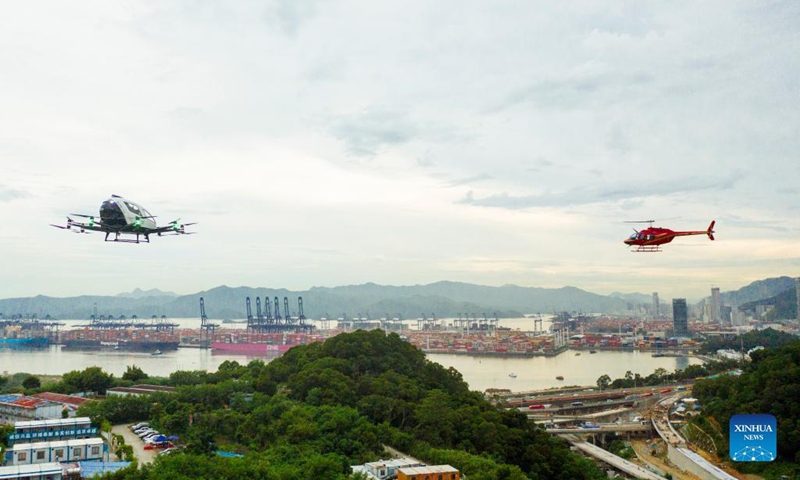Chinese cities speed up low-altitude economy, a new force driving development

Aerial photo taken on Sept. 14, 2021, shows the demo flights of a Bell 206 helicopter (R) from HELI-EASTERN, a low-altitude general aviation carrier and helicopter service provider, and a passenger-grade autonomous aerial vehicle (AAV) from EHang, a leading AAV technology platform company, in an integrated airspace in Shenzhen, south China's Guangdong Province. (Photo: Xinhua)
From modern delivery services to rural agriculture, China's low-altitude economy has emerged as a strategic industry driving innovation and development. Cities across China are offering incentives and making deployments to further develop the potential of the industry, which is expected to reach 2 trillion yuan ($275.7 billion) in 2030.
Wuhan, Central China's Hubei Province has issued a set of measures to support the high-quality development of the low-altitude economy, to be effective on June 28.
These measures offer incentives of up to 10 million yuan for major projects to establish themselves in the city, encouraging companies to upgrade to intelligent equipment and establish national-level innovation hubs.
Guangzhou, the capital city of South China's Guangdong Province released a plan to develop the low-altitude economy, aiming to reach 150 billion yuan by 2027.
The city aims to achieve a market size of 30 billion yuan in key low-altitude operational services such as short-distance passenger transport, cultural tourism, logistics, emergency medical services, and exhibition services. In terms of the low-altitude infrastructure, it aims to build more than five vertical takeoff and landing hubs, and more than 100 regular-use takeoff and landing points, with an investment of more than 10 billion yuan in low-altitude infrastructure.
The low-altitude economy, which was included in this year's Government Work Report, is a burgeoning industry and typical representative of the new quality productive forces that serve as a primary catalyst for driving economic development.
According to the Civil Aviation Administration of China, the low-altitude economy exceeded 500 billion yuan in 2023 and is expected to reach 2 trillion yuan by 2030.
Experts believe that the low-altitude economy is to accelerate and become a significant engine for economic growth.
China's low-altitude economy will inject new momentum into the nation's development of new quality productive forces, Pan Helin, a member of the Expert Committee for Information and Communication Economy under the Ministry of Industry and Information Technology, told the Global Times on Tuesday.
The rise of the low-altitude economy, driven by technological advances, has the potential to revolutionize various industries and foster high-value jobs, as well as bolster innovation in science and technology, Pan said.
Taking drones as example, they can be utilized in agriculture, logistics and other emerging consumer markets, in an effort to enhance productivity, cut expenses and stimulate economic progress, Pan added.
Wang Peng, a research fellow at the Beijing Academy of Social Sciences, told the Global Times on Tuesday that the drone and low-altitude tourism industries are important areas for the development of the low-altitude economy.
Wang said that drones will be the first industry to take off in the low-altitude economy, with simplified regulations and increased demand for fast logistics.
The electric vertical takeoff and landing (eVTOL) industry is also at a turning point of commercialization, where applications will mainly focus on tourism, logistics, and emergency rescue scenarios in the short to medium term, and gradually expand to urban and regional passenger transportation services, Wang added.
Chinese intelligent aircraft company EHang secured the world's first production certificate for its EH216-S eVTOL aircraft for mass production in April.
With a designed speed of 130 kilometers per hour, a maximum range of 30 kilometers, and a maximum flight time of 25 minutes, it can be widely used in passenger transportation, tourism, logistics, medical emergency rescues, and other scenarios, according to the company.
In the first quarter, EHang achieved a record of 26 deliveries of its EH216-S eVTOL aircraft, doubling from the previous year.
In response to the huge market potential, China authorities have recently released support policies to optimize the development of the low-altitude industry and promote its high-quality development.
The CAAC in May announced that it would expand the available low-altitude flying areas, enhance services for flying, and improve the infrastructure and operations at airports and landing points.
Photos
Related Stories
- Shenyang provides solid foundation for development of low-altitude economy
- Come to China for an exciting low-altitude adventure
- Low-altitude economy soars as new growth engine in Wuhu, E China’s Anhui
- Hainan's low-altitude economy soaring high
- China's technology companies provide aerial vehicle products, solutions for many industries
- Low-altitude economy takes off in China
Copyright © 2024 People's Daily Online. All Rights Reserved.









